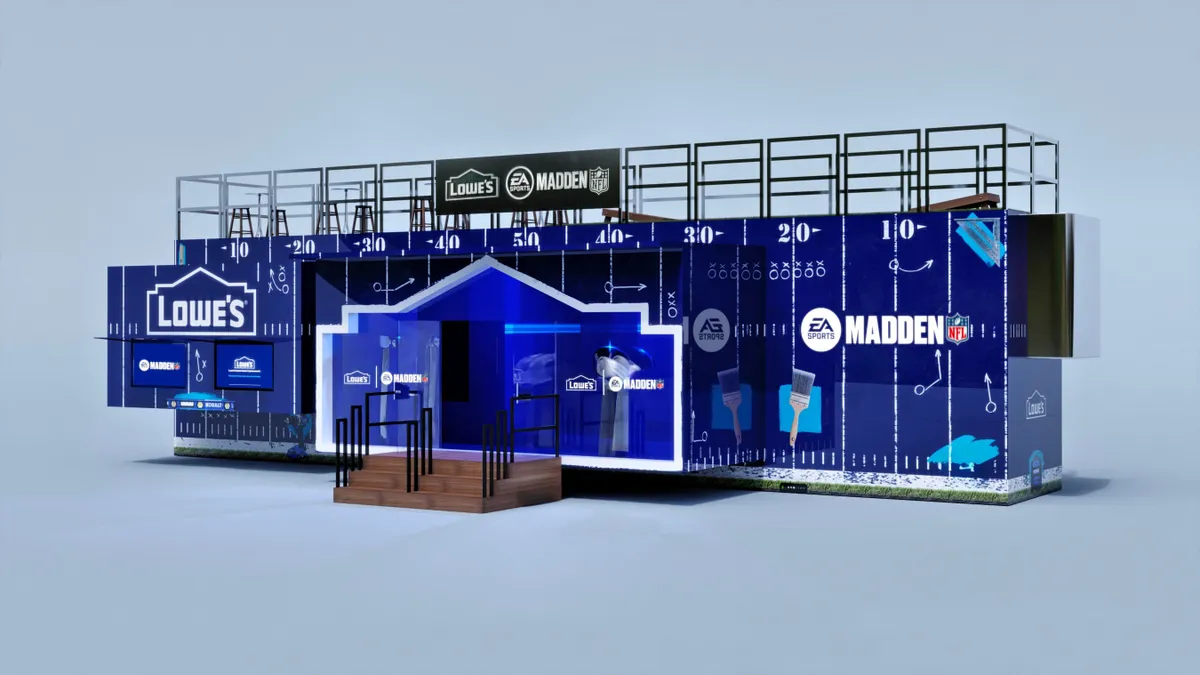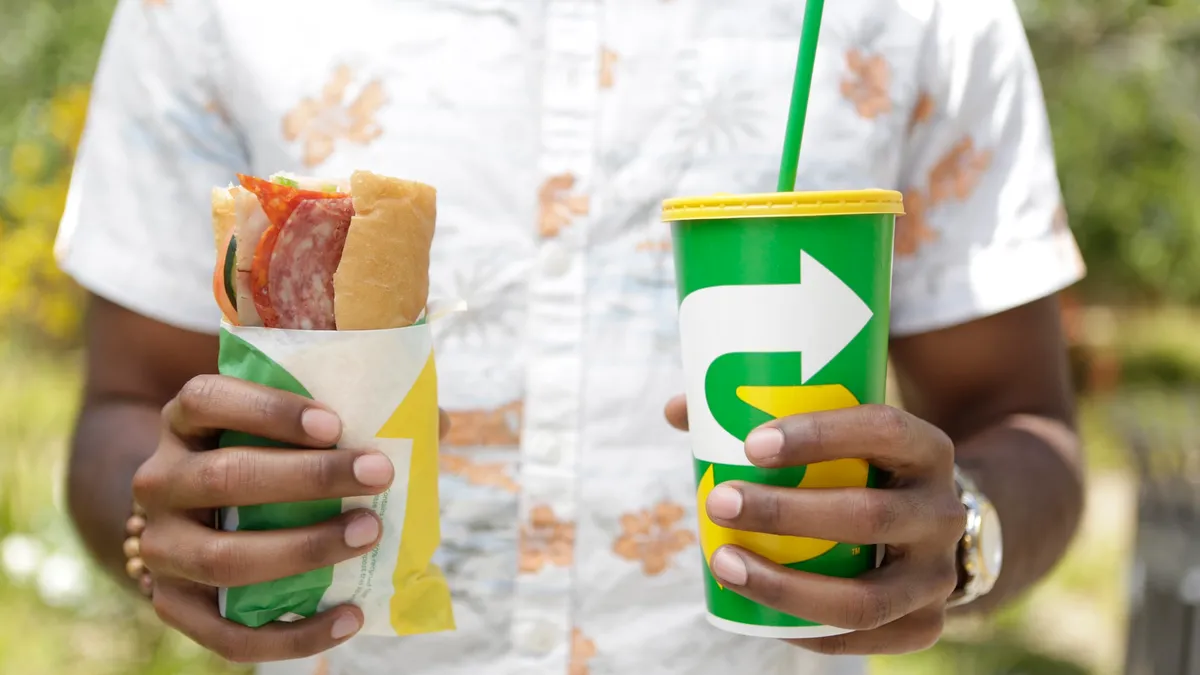At a glance, it looked like business as usual at Advertising Week New York last week. But after 18-plus months of significant upheaval, change was also evident, with attendees reporting they heard less fluff than usual on the four-day agenda, along with clearer-eyed looks at where people are placing their bets as they try to navigate a quickly changing consumer landscape.
After being strictly virtual last fall, this year's hybrid event was viewed by some as a sort of homecoming, with the industry's eagerness to step back out into the world evident in the hustle and bustle of the well-attended conference, which took place at 20 Hudson Yards. There were, of course, signifiers of the pandemic: mandated vaccination for entry, plenty of masks — which were required to get into live discussions, but otherwise worn fairly loosely — and signs emphasizing COVID-19 safety. Amid ongoing uncertainty about what exactly that world will look like going forward, attendees and speakers appeared more open to taking risks.
"That's the first time I noticed a lot of companies and brands getting a little bit outside of their comfort zone or their standard strategies," said Roey Franco, vice president of product and innovation at WPP's Xaxis agency, during a sit-down interview on the final day of the event.
"I would attribute it perhaps to the last year, because I think things changed not only on a business level, but people on a personal level have changed their habits," Franco said. "Human beings' behaviors can change very drastically over the course of a few months, and it's literally live or die for a brand."
At the show, Franco noticed an increased candor around nascent concepts like the metaverse from brands that are usually tighter-lipped about their plans for unproven channels.
Long shadows
The overall optimistic vibe could sometimes belie severe disruptions impacting the industry on the outside, with several issues of the day casting long shadows.
"The role of the CMO — whatever companies want to call it — is, I think, one of the least enviable positions that's out there."

Ryan Pauley
Chief revenue officer, Vox Media
Supply chain and inflation pressures that have reportedly led some brands to peel back on marketing spending for the key holiday period frequently reared up in otherwise easygoing talks, with leaders keeping their fingers crossed that the fallout will remain a relatively short-term obstacle.
"I call it the best of times, I can't say it's the worst of times, but it's certainly the most challenging and interesting times," Craig Brommers, CMO of American Eagle, said in a chat with Roku.
"Like basically every industry out there, the apparel/retail industry certainly faces some interesting challenges as we head into Q4. One is, of course, the supply chain and operational issues that everyone is facing. Two is, we have clocked in record margins in fiscal '21," Brommers added. "Q4 tends to be a bit more promotional, and so: How much do you push on promotions or how much do you retain that pricing power is a really fascinating dynamic for us going forward."
Proliferating mandates weighing on the CMO were a recurrent theme at Advertising Week this year, with Brommers noting that driving business is becoming as big an agenda item as growing brands.
On top of pandemic and operational woes, marketers are inching closer to the deprecation of third-party cookies, a bedrock method of ad-targeting, and grappling with changes to Apple's tracking technology that are starting to pinch performance on social media platforms like Snapchat and Facebook.
"As we look at all of these changes, as marketers, as publishers, as even subscription services, people are going to be more in control of their data," Cadillac CMO Melissa Grady said during an early session. "So we have to start to operate in a way of: What is this negotiation of your information versus us just trying to collect it?"
Perhaps tellingly, one of the bleaker assessments of the C-suite spot came from someone not on the brand side of the industry.
"The role of the CMO — whatever companies want to call it — is, I think, one of the least enviable positions that's out there," said Ryan Pauley, chief revenue officer at Vox Media, during the panel with Grady.
"You've got to have your pulse on the data, the creative, the channel investment in different mediums ... not taking into account all the sorts of other stakeholders that go into the customer or other stakeholders in the company," he added. "It's a very complex position."
Still chasing Gen Z
Well-fashioned targeting strategies and creative concepts obviously don't matter much if the audience isn't interested in ads. Gen Z's advertising aversion and general elusiveness have been well-documented in the marketing sphere for years, but speakers at Advertising Week pointed to emerging tech solutions and platforms that hold promise.
"Every single data point that I see would suggest that Gen Z doesn't even know what linear television is. They are streaming, they are on the social networks all day long, and so we're going to follow them," said Brommers. "I think we're particularly bullish about social commerce."
American Eagle has successfully keyed into Gen Z tastes amid a tough period for apparel, with a strong presence on apps like TikTok where it has experimented with shopping capabilities.
"Your algorithm is not going to tell you what Gen Z is doing, I promise you,"

Jessica Spaulding
Head of marketing, Cheetos
In August, the brand introduced its first digital clothing collection through Snap's Bitmoji avatar creation platform. The campaign included tests of an augmented reality experience that let users virtually try on and buy selected looks directly on Snapchat using the front-facing camera.
The convergence of marketing and commerce can create a breakneck pace, but also more opportunities to tap into the social moments that Gen Z gravitates toward, per Brommers.
"Brands have to be the best storytellers out there, and given the climate that we're operating in, there are literally day-to-day, week-to-week stories that we want to communicate with our customers," the executive said.
Others cautioned that marketers can't take traditional approaches to researching and understanding Gen Z, another testament to how fast the group's tastes can change. Jessica Spaulding, head of marketing for Cheetos at Frito Lay, claimed she operates "burner accounts" posing as members of the cohort to glean deeper knowledge about the generation and better tailor her social feeds to their interests.
"Your algorithm is not going to tell you what Gen Z is doing, I promise you," Spaulding said during a panel titled "Don't Call Them Gen Z — They Hate That."
Spaulding at the same time urged marketers to consider the intense upheaval that Gen Z and younger demographics like Gen Alpha — generally painted as kids 11 years or younger — have endured under the pandemic. She indicated the aftereffects of the health crisis could carry a pointed impact on how the consumers of the future behave.
"You need to understand that [their] wider life has been disrupted in the last year," Spaulding said. "If you lost some of your college years and your formative social years in high school or junior high, that is going to forever change the fabric of our society."
Loosening up
One tactic proven to resonate with the younger crowd is the savvy deployment of influencers, whether those be gaming streamers or mega-celebrities like Bad Bunny who has a partnership with Cheetos that recently added a leisurewear line developed in collaboration with Adidas. Other marketers, including Mars Wrigley and Nestlé, used Advertising Week to champion creator-driven campaigns, and a common thread between them was a willingness to give up a degree of control when it came to creative direction and execution.
"Sometimes you have to zip it and let the artist or the celebrity ... tell you how to really communicate," Spaulding said.
That sentiment is becoming increasingly common as brands put more trust in influencer marketing in a broad sense. A recent Kantar report found that marketers rank influencer marketing as their No. 3 most-trusted media channel, a noteworthy jump from 10th place last year. In the research, analysts noted the change could be attributed to the space maturing "with increased regulation, a new breed of agencies and more orderly systems and processes for the creation, scaling and measurement of influencer campaigns."
While there's lingering trepidation — small-bit influencers and mega-watt stars alike can be prone to putting their foot in their mouth — brands interested in capitalizing on the creator economy might just need to take the plunge and see how it shakes out.
"I guess you're always nervous when you give your brand over to someone who's just joining you for the first time," said Michael Italia, head of social media and the digital content studio at Mars Wrigley, on a panel discussing the re-emergence of an old Starburst commercial on TikTok — a viral trend largely driven by the app's creator community.
"You don't exactly know where they're gonna go with it ... so there's a level of trust indeed, as well as that apprehension," Italia added. "But at the end of the day, they always kind of come through and they always make what their audience loves."
One-size-fits-all?
As usual, Advertising Week was host not only to strategic insights, but also a flurry of announcements. Nielsen, battered by controversies surrounding its measurement business, kicked off the show with its most extensive rebrand in ages; the grocery chain Kroger unveiled a private programmatic marketplace leaning on its troves of first-party shopper data.
"We've created more walls than ever before with the announcements of new 'data first' initiatives when no buyers are looking for more bifurcation..."

Vinny Rinaldi
Head of investment and activation, Wavemaker
In the wake of cookie deprecation and the radical shift to digital media under the pandemic, such offerings have some marketers excited but might only serve as stopgaps in addressing digital's current messiness.
"We continue to think everything is a one size fits all approach as an industry and we take little to no time of truly understanding each specific business challenges and how to solve them," said Vinny Rinaldi, head of investment and activation at GroupM's Wavemaker agency, in emailed post-show comments.
"We can no longer look at the ecosystem in a myopic way and we need to start thinking about diversification across the supply chain," added Rinaldi. "We've created more walls than ever before with the announcements of new 'data first' initiatives when no buyers are looking for more bifurcation, we need tools and supply to solve a cross-channel distribution of how we buy media."
As marketers come under greater pressure to clear these obstacles in the months ahead, one avenue holds promise: the chance for more face-to-face meetings to hash out the nitty-gritty details.
"At the end of the day, meeting people in-person and having that connection is always helpful, both for business but also on a personal level," Xaxis' Franco said.























